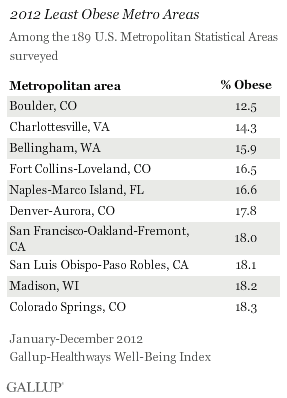WASHINGTON, D.C. -- For the third consecutive year, residents of the Boulder, Colo., metro area are the least likely to be obese, at 12.5% in 2012. Residents of McAllen-Edinburg-Mission, Texas, continue to be the most likely to be obese, at 38.5%. Adult obesity rates are higher than 15% in all but two of the 189 metro areas that Gallup and Healthways surveyed in 2012.


Along with the McAllen-Edinburg-Mission metro area, Beaumont-Port Arthur, Texas; Reading, Pa.; and Huntington-Ashland, W.Va.-Ky.-Ohio, are among the 10 areas with the highest obesity rates for three years in a row. Boulder; Fort Collins-Loveland, Colo.; Naples-Marco Island, Fla.; and San Francisco-Oakland-Fremont, Calif., have been among the locations with the lowest obesity rates since Gallup and Healthways started reporting them in 2010.
The metro areas with the 11 highest obesity rates in 2012 had an average obesity rate of 34.1%, while the metro areas with the 10 lowest obesity rates averaged 16.6%. Neither average differs substantially from the 2011 averages of 34.8% and 15.9%, respectively.
Nationwide, 26.2% of Americans aged 18 and older were obese in 2012, unchanged from 26.1% in 2011. Of the 189 reportable metro areas surveyed in 2012, 102 had obesity rates lower than the national average. Nineteen of the 25 most populous metro areas surveyed boasted obesity rates lower than the national average. Smaller metro areas were more likely to have above-average obesity rates, consistent with past reporting.
Gallup tracks U.S. obesity levels as part of the Gallup-Healthways Well-Being Index, using Americans' self-reported height and weight to calculate Body Mass Index (BMI) scores. BMI scores of 30 or higher are considered obese.
These metro area findings are based on interviews with 248,538 U.S. adults, aged 18 and older, living in ZIP codes that map to each respective metro area. Gallup categorizes U.S. metro areas according to the U.S. Office of Management and Budget's definitions for Metropolitan Statistical Areas (MSAs) and reports on all MSAs for which there are a minimum of 300 interviews available.
Residents of the Most Obese Areas More Likely to Be Low-Income
In the 11 metro areas with the highest obesity rates, the average annual wages are lower than in the 10 areas with the lowest obesity rates, reflecting the link between obesity and poverty. The average annual wage in the 11 areas with the highest obesity rates is $38,550, this compares with an average annual income of $47,783 for the 10 areas with the lowest obesity rates. Additionally, residents in the most obese areas, on average, earn $7,240 below the national mean wage of $45,790, while residents of the least obese areas average $1,993 more annually than the national mean wage.
Residents in the areas with the highest obesity rates are also 7.9 percentage points less likely than are those in the areas where obesity is lowest to have enough money to be able to buy food at all times. They are also 6.5 points less likely to have enough money for healthcare and medicine.

Bottom Line
Obesity remains a prevalent and costly problem in America. In 2012, the U.S. did not make progress toward the Centers for Disease Control and Prevention's nationwide goal to reduce obesity to 15%. The Gallup-Heathways Well-Being Index national obesity rate remained steady at 26.2% and just two metro areas had obesity rates below 15%, which is down from three in 2011.
Residents of the cities with the highest obesity rates receive on average lower annual wages and are less likely to be able to consistently afford food and healthcare than residents of the cities with the lowest obesity rates.
The complexity of decreasing obesity must be met with community and workforce leaders moving in tandem to promote the health of citizens and employees. By working together to educate and offer insights into healthier lifestyles, both companies and communities can benefit.
About the Gallup-Healthways Well-Being Index
The Gallup-Healthways Well-Being Index tracks well-being in the U.S. and provides best-in-class solutions for a healthier world. To learn more, please visit well-beingindex.com.
Survey Methods
Results are based on telephone interviews conducted as part of the Gallup-Healthways Well-Being Index survey Jan. 1-Dec. 31, 2012, with a random sample of 353,564 adults, aged 18 and older, living in all 50 U.S. states and the District of Columbia, selected using random-digit-dial sampling.
For results based on the total sample of national adults, one can say with 95% confidence that the margin of sampling error is ±1 percentage point.
The margin of sampling error for most states is ±1 to ±2 percentage points, but is as high as ±4 points for states with smaller population sizes such as Alaska, Rhode Island, Vermont, Wyoming, North Dakota, South Dakota, Delaware, and Hawaii.
Interviews are conducted with respondents on landline telephones and cellular phones, with interviews conducted in Spanish for respondents who are primarily Spanish-speaking. Each sample includes a minimum quota of 400 cellphone respondents and 600 landline respondents per 1,000 national adults, with additional minimum quotas among landline respondents by region. Landline telephone numbers are chosen at random among listed telephone numbers. Cellphone numbers are selected using random-digit-dial methods. Landline respondents are chosen at random within each household on the basis of which member had the most recent birthday.
Samples are weighted by gender, age, race, Hispanic ethnicity, education, region, adults in the household, and phone status (cell phone only/landline only/both, cell phone mostly, and having an unlisted landline number). Demographic weighting targets are based on the March 2011 Current Population Survey figures for the aged 18 and older non-institutionalized population living in U.S. telephone households while MSA weighting targets are based on the 2012 Nielsen Claritas Dataset. All reported margins of sampling error include the computed design effects for weighting.
In addition to sampling error, question wording and practical difficulties in conducting surveys can introduce error or bias into the findings of public opinion polls.
For more details on Gallup's polling methodology, visit https://www.gallup.com/.
